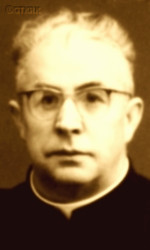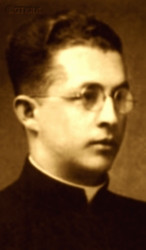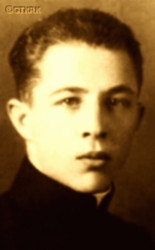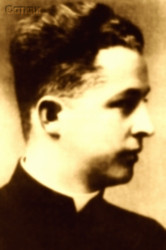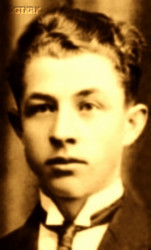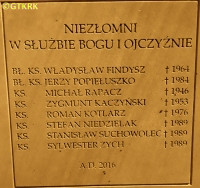Roman Catholic
St Sigismund parish
05-507 Słomczyn
85 Wiślana Str.
Konstancin deanery
Warsaw archdiocese, Poland
full list:
displayClick to display full list

searchClick to search full list by categories
wyświetlKliknij by wyświetlić pełną listę po polsku

szukajKliknij by przeszukać listę wg kategorii po polsku

Martyrology of the clergy — Poland
XX century (1914 – 1989)
personal data
religious status
blessed
surname
FINDYSZ
forename(s)
Vladislav (pl. Władysław)
function
diocesan priest
creed
Latin (Roman Catholic) Church RCmore on
en.wikipedia.org
[access: 2014.09.21]
diocese / province
Przemyśl diocesemore on
www.przemyska.pl
[access: 2013.02.15]
RC Military Ordinariate of Polandmore on
en.wikipedia.org
[access: 2014.12.20]
honorary titles
Rochettum et Mantolettum canonmore on
Rochettum et Mantolettum canon
(21.06.1957)
Expositorii Canonicalis canonmore on
Expositorii Canonicalis canon
(14.11.1946)
date and place
of death
21.08.1964

Żmigród Nowytoday: Nowy Żmigród, Nowy Żmigród gm., Jasło pov., Subcarpathia voiv., Poland
more on
en.wikipedia.org
[access: 2021.05.30]
details of death
After the German and Russian invasion of Poland in 09.1919 and the beginning of World War II, after the start of German occupation, during his ministry in Jasło, became involved in the clandestine activities of Polish independence resistance organizations. In 1940, the District Command of the Armed Struggle Union ZWZ (transformed in 1942 into the Home Army AK, part of the Polish Clandestine State) was formed in Jasło, subordinated to the Command of the ZWZ Inspectorate in Krosno. The ZWZ organized the transfer of soldiers and officers of the Polish Army in hiding, through the mountains, via Slovakia, to Hungary, and further to the West, where the Polish government and the Polish army operated; it collected and stored weaponry. In the same 1940, the Peasant Guard organisation began its conspiratorial activities in Jasło (later transformed into the Peasant Battalions BCh). Became the chaplain of the emerging resistance groups of the Polish underground.
Prob. in 08.1944, due to the approaching front and Russian troops, was forcibly displaced by the Germans from his Żmigród parish. Prob. this was also related to the German action aimed at the Home Army AK — in 08.1944, the Germans arrested many members of the resistance movement in Żmigród and then murdered them. A month later, on 08.09.1944, the Russian Dukla–Prešov Operation began, aimed at opening a route to Slovakia through the mountains. The fighting lasted until 30.11.1944, including attempts to take control over the Żmigród–Dukla road. The losses of Russian troops, and the Czech units supporting them, are estimated at up to 170,000 killed, wounded and missing. German and Hungarian losses — c. 100,000. The road to Slovakia was not secured. Jasło and Żmigród — both towns completely destroyed — the Russians captured only on c. 16.01.1945, when the winter offensive of 1945 began, which led to the German defeat and the end of military hostilities of the World War II.
Then was able to return to his parish, but found the church destroyed, the most valuable objects stolen by German troops. The Russian occupation began, supported by Polish Commie‐Nazis.
When in 05.1952 the Commie‐Nazi authorities issued a decision banning him from teaching religion in primary schools, when they also began to liquidate extracurricular catechetical points, protested against state interference in the affairs of the Church and religion.
Began to be spied on by the Commie‐Nazi UB, the Polish unit of the Russian criminal MGB.
When the Second Vatican Council began in 1962, joined the „conciliar acts of kindness” campaign. Called on his parishioners to renew their religious life, return to Christian customs and moral renewal.
In response, on 25.11.1963 was arrested by the Commie‐Nazis. Accused of „persecuting and discriminating against non‐believers”.
On 17.12.1963 sentenced to 2.5 years in prison for „forcing to follow religious practices”.
Imprisoned in the Castle in Rzeszów, and from spring 1964 in the prison Montelupich Str. in Krakow.
Humiliated, physically and mentally harassed.
Not allowed to undergo a previously planned throat operation due to a suspicion of cancer.
Without treatment, became seriously ill and was released on 29.02.1964 in a state of extreme exhaustion.
Perished soon after, without regaining his health.
cause of death
extermination
perpetrators
Russians / Poles
sites and events
Cracow (Montelupich)Click to display the description, RzeszówClick to display the description, Ribbentrop‐MolotovClick to display the description, Pius XI's encyclicalsClick to display the description
date and place
of birth
13.12.1907

Krościenko Niżnetoday: district of Krosno, Krosno city pov., Subcarpathia voiv., Poland
more on
en.wikipedia.org
[access: 2021.10.09]
parents
FINDYSZ Stanislav
🞲 1872, ? — 🕆 1941, Krościenko Niżnetoday: district of Krosno, Krosno city pov., Subcarpathia voiv., Poland
more on
en.wikipedia.org
[access: 2021.10.09]

RACHWAŁ Apolonia
🞲 1884, ? — 🕆 1912, Krościenko Niżnetoday: district of Krosno, Krosno city pov., Subcarpathia voiv., Poland
more on
en.wikipedia.org
[access: 2021.10.09]
baptism
14.12.1907

Krosnotoday: Krosno city pov., Subcarpathia voiv., Poland
more on
en.wikipedia.org
[access: 2021.10.09]
Holy Trinity RC church
presbyter (holy orders)
ordination
19.06.1932

Przemyśltoday: Przemyśl city pov., Subcarpathia voiv., Poland
more on
en.wikipedia.org
[access: 2021.04.01]
Assumption of the Blessed Virgin Mary and St John the Baptist RC cathedral churchmore on
en.wikipedia.org
[access: 2025.03.14]
positions held
1962 – 1964
dean — Żmigród Nowytoday: Nowy Żmigród, Nowy Żmigród gm., Jasło pov., Subcarpathia voiv., Poland
more on
en.wikipedia.org
[access: 2021.05.30] RC deanery
1942 – 1964
parish priest — Żmigród Nowytoday: Nowy Żmigród, Nowy Żmigród gm., Jasło pov., Subcarpathia voiv., Poland
more on
en.wikipedia.org
[access: 2021.05.30] ⋄ St Peter and St Paul the Apostles RC parish ⋄ Żmigród Nowytoday: Nowy Żmigród, Nowy Żmigród gm., Jasło pov., Subcarpathia voiv., Poland
more on
en.wikipedia.org
[access: 2021.05.30] RC deanery
1941 – 1942
administrator — Żmigród Nowytoday: Nowy Żmigród, Nowy Żmigród gm., Jasło pov., Subcarpathia voiv., Poland
more on
en.wikipedia.org
[access: 2021.05.30] ⋄ St Peter and St Paul the Apostles RC parish ⋄ Żmigród Nowytoday: Nowy Żmigród, Nowy Żmigród gm., Jasło pov., Subcarpathia voiv., Poland
more on
en.wikipedia.org
[access: 2021.05.30] RC deanery
1940 – 1941
vicar — Jasłotoday: Jasło urban gm., Jasło pov., Subcarpathia voiv., Poland
more on
en.wikipedia.org
[access: 2021.10.09] ⋄ Assumption of the Blessed Virgin Mary RC parish ⋄ Jasłotoday: Jasło urban gm., Jasło pov., Subcarpathia voiv., Poland
more on
en.wikipedia.org
[access: 2021.10.09] RC deanery
1939 – 1940
administrator — Strzyżówtoday: Strzyżów gm., Strzyżów pov., Subcarpathia voiv., Poland
more on
en.wikipedia.org
[access: 2021.10.09] ⋄ Corpus Christi RC parish ⋄ Strzyżówtoday: Strzyżów gm., Strzyżów pov., Subcarpathia voiv., Poland
more on
en.wikipedia.org
[access: 2021.10.09] RC deanery — after the death of the parish priest, Fr Louis Bira, at the very beginning of the German occupation
1937 – 1939
vicar — Strzyżówtoday: Strzyżów gm., Strzyżów pov., Subcarpathia voiv., Poland
more on
en.wikipedia.org
[access: 2021.10.09] ⋄ Corpus Christi RC parish ⋄ Strzyżówtoday: Strzyżów gm., Strzyżów pov., Subcarpathia voiv., Poland
more on
en.wikipedia.org
[access: 2021.10.09] RC deanery
1935 – 1937
vicar — Drohobychtoday: Drohobych urban hrom., Drohobych rai., Lviv obl., Ukraine
more on
en.wikipedia.org
[access: 2021.10.09] ⋄ Assumption of the Blessed Virgin Mary, Holy Cross and St Bartholomew the Apostle RC parish ⋄ Drohobychtoday: Drohobych urban hrom., Drohobych rai., Lviv obl., Ukraine
more on
en.wikipedia.org
[access: 2021.10.09] RC deanery
1932 – 1935
vicar — Boryslavtoday: Boryslav urban hrom., Drohobych rai., Lviv obl., Ukraine
more on
en.wikipedia.org
[access: 2020.11.01] ⋄ St Barbara the Virgin and Martyr RC parish ⋄ Drohobychtoday: Drohobych urban hrom., Drohobych rai., Lviv obl., Ukraine
more on
en.wikipedia.org
[access: 2021.10.09] RC deanery
1927 – 1932
student — Przemyśltoday: Przemyśl city pov., Subcarpathia voiv., Poland
more on
en.wikipedia.org
[access: 2021.04.01] ⋄ philosophy and theology, Theological Seminary
others related
in death
BIRAClick to display biography Louis
sites and events
descriptions
Cracow (Montelupich): Cracow penal prison, during occupation run by the Germans — from 28.02.1941 by Germ. Geheime Staatspolizei (Eng. Secret State Police, known as Gestapo. In 1940‐1944 Germans jailed there approx. 50,000 prisoners, mainly Poles and Jews. Some of them were transported to KL Auschwitz concentration camp, some were executed. After cease in war effort the prison was used by UB — a Polish unit of Russian NKVD — as a prison for Polish independence resistance fighters, some of which were subsequently sent to prisons and slave labour camps in Russia. (more on: en.wikipedia.orgClick to attempt to display webpage
[access: 2014.10.31])
Rzeszów: During German occupation penal prison run by the Germans set up in Rzeszów Castle. At any one time more than 2,500 prisoners were held there (for instance from 01.04.1943 till 01.03.1944), mainly Poles. In the Castle basements and on prison yard executions were carried out of those sentenced by the German Sondergericht (Eng. special court) kangaroo court — other prisoners of the Castle were executed by the Germans at other sites in Rzeszów as well. After German withdrawal on 02.08.1944 and capture of Rzeszów by the Russians the prison was taken over initially by the Russian genocidal NKVD and then by Polish UB, a unit of murderous Russian NKVD. Thousands, of prisoners — Polish political activists and partisans, members of various clandestine organizations (among others from Home Army AK, part of Polish Clandestine State, and Freedom and Independence WiN) — were then held captive there. Local AK leader, Col. Lukas Ciepliński, future chairman of 4th Command of WiN, murdered by Commie‐Nazis in 1951, reported in 1944 that „during interrogations even women are brutally beaten. The processes […] are led by NKVD” and „the prisoners’ situation […] is dreadful. They simply perish from hunger. The food in German times compared to today was simply a luxury”. Executions of those held — Polish independence activists, but also German war criminals and Ukrainian nationalist — were also, as done by the Germans, carried out then in the Castle, in Castle’s basements and on the gallows in the prison yard. (more on: www.sw.gov.plClick to attempt to display webpage
[access: 2013.12.04])
Ribbentrop‐Molotov: Genocidal Russian‐German alliance pact between Russian leader Joseph Stalin and German leader Adolf Hitler signed on 23.08.1939 in Moscow by respective foreign ministers, Mr. Vyacheslav Molotov for Russia and Joachim von Ribbentrop for Germany. The pact sanctioned and was the direct cause of joint Russian and German invasion of Poland and the outbreak of the World War II in 09.1939. In a political sense, the pact was an attempt to restore the status quo ante before 1914, with one exception, namely the „commercial” exchange of the so‐called „Kingdom of Poland”, which in 1914 was part of the Russian Empire, fore Eastern Galicia (today's western Ukraine), in 1914 belonging to the Austro‐Hungarian Empire. Galicia, including Lviv, was to be taken over by the Russians, the „Kingdom of Poland” — under the name of the General Governorate — Germany. The resultant „war was one of the greatest calamities and dramas of humanity in history, for two atheistic and anti‐Christian ideologies — national and international socialism — rejected God and His fifth Decalogue commandment: Thou shall not kill!” (Abp Stanislav Gądecki, 01.09.2019). The decisions taken — backed up by the betrayal of the formal allies of Poland, France and Germany, which on 12.09.1939, at a joint conference in Abbeville, decided not to provide aid to attacked Poland and not to take military action against Germany (a clear breach of treaty obligations with Poland) — were on 28.09.1939 slightly altered and made more precise when a treaty on „German‐Russian boundaries and friendship” was agreed by the same murderous signatories. One of its findings was establishment of spheres of influence in Central and Eastern Europe and in consequence IV partition of Poland. In one of its secret annexes agreed, that: „the Signatories will not tolerate on its respective territories any Polish propaganda that affects the territory of the other Side. On their respective territories they will suppress all such propaganda and inform each other of the measures taken to accomplish it”. The agreements resulted in a series of meeting between two genocidal organization representing both sides — German Gestapo and Russian NKVD when coordination of efforts to exterminate Polish intelligentsia and Polish leading classes (in Germany called «Intelligenzaktion», in Russia took the form of Katyń massacres) where discussed. Resulted in deaths of hundreds of thousands of Polish intelligentsia, including thousands of priests presented here, and tens of millions of ordinary people,. The results of this Russian‐German pact lasted till 1989 and are still in evidence even today. (more on: en.wikipedia.orgClick to attempt to display webpage
[access: 2015.09.30])
Pius XI's encyclicals: Facing the creation of two totalitarian systems in Europe, which seemed to compete with each other, though there were more similarities than contradictions between them, Pope Pius XI issued in 03.1937 (within 5 days) two encyclicals. In the „Mit brennender Sorge” (Eng. „With Burning Concern”) published on 14.03.1938, condemned the national socialism prevailing in Germany. The Pope wrote: „Whoever, following the old Germanic‐pre‐Christian beliefs, puts various impersonal fate in the place of a personal God, denies the wisdom of God and Providence […], whoever exalts earthly values: race or nation, or state, or state system, representatives of state power or other fundamental values of human society, […] and makes them the highest standard of all values, including religious ones, and idolizes them, this one […] is far from true faith in God and from a worldview corresponding to such faith”. On 19.03.1937, published „Divini Redemptoris” (Eng. „Divine Redeemer”), in which criticized Russian communism, dialectical materialism and the class struggle theory. The Pope wrote: „Communism deprives man of freedom, and therefore the spiritual basis of all life norms. It deprives the human person of all his dignity and any moral support with which he could resist the onslaught of blind passions […] This is the new gospel that Bolshevik and godless communism preaches as a message of salvation and redemption of humanity”… Pius XI demanded that the established human law be subjected to the natural law of God , recommended the implementation of the ideal of a Christian state and society, and called on Catholics to resist. Two years later, National Socialist Germany and Communist Russia came together and started World War II. (more on: www.vatican.vaClick to attempt to display webpage
[access: 2023.05.28], www.vatican.vaClick to attempt to display webpage
[access: 2023.05.28])
sources
personal:
pl.wikipedia.orgClick to attempt to display webpage
[access: 2014.12.20], www.nasza-arka.plClick to attempt to display webpage
[access: 2014.12.20], www.brewiarz.plClick to attempt to display webpage
[access: 2014.12.20]
bibliographical:
„Schematismus Venerabilis Cleri Dioecesis PremisliensisClick to display source page”, Przemyśl diocesa Curia, from 1866 to 1938
original images:
ipn.gov.plClick to attempt to display webpage
[access: 2014.12.20], www.nasza-arka.plClick to attempt to display webpage
[access: 2014.12.20], wsd.przemyska.plClick to attempt to display webpage
[access: 2015.09.30], www.brewiarz.plClick to attempt to display webpage
[access: 2014.12.20], www.nasza-arka.plClick to attempt to display webpage
[access: 2015.09.30], info.wiara.plClick to attempt to display webpage
[access: 2014.12.20]
LETTER to CUSTODIAN/ADMINISTRATOR
If you have an Email client on your communicator/computer — such as Mozilla Thunderbird, Windows Mail or Microsoft Outlook, described at WikipediaPatrz:
en.wikipedia.org, among others — try the link below, please:
LETTER to CUSTODIAN/ADMINISTRATORClick and try to call your own Email client
If however you do not run such a client or the above link is not active please send an email to the Custodian/Administrator using your account — in your customary email/correspondence engine — at the following address:

giving the following as the subject:
MARTYROLOGY: FINDYSZ Vladislav
To return to the biography press below:
 Click to return to biography
Click to return to biography








